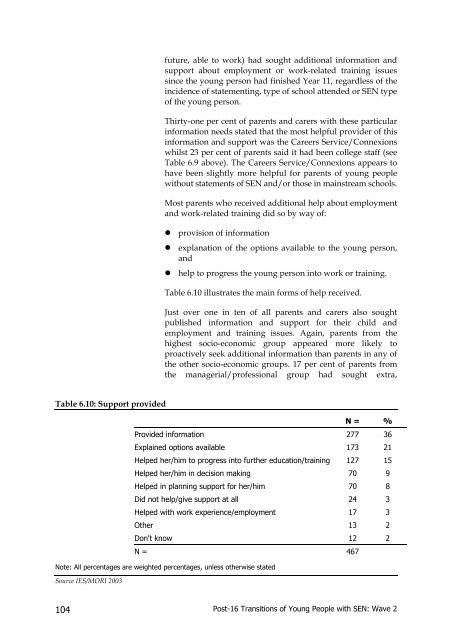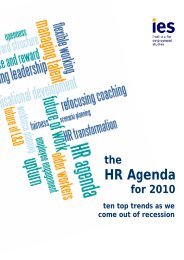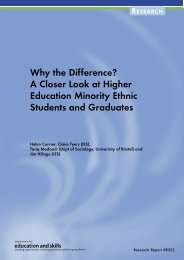Post-16 Transitions: a Longitudinal Study of Young People with ...
Post-16 Transitions: a Longitudinal Study of Young People with ...
Post-16 Transitions: a Longitudinal Study of Young People with ...
Create successful ePaper yourself
Turn your PDF publications into a flip-book with our unique Google optimized e-Paper software.
future, able to work) had sought additional information and<br />
support about employment or work-related training issues<br />
since the young person had finished Year 11, regardless <strong>of</strong> the<br />
incidence <strong>of</strong> statementing, type <strong>of</strong> school attended or SEN type<br />
<strong>of</strong> the young person.<br />
Thirty-one per cent <strong>of</strong> parents and carers <strong>with</strong> these particular<br />
information needs stated that the most helpful provider <strong>of</strong> this<br />
information and support was the Careers Service/Connexions<br />
whilst 23 per cent <strong>of</strong> parents said it had been college staff (see<br />
Table 6.9 above). The Careers Service/Connexions appears to<br />
have been slightly more helpful for parents <strong>of</strong> young people<br />
<strong>with</strong>out statements <strong>of</strong> SEN and/or those in mainstream schools.<br />
Most parents who received additional help about employment<br />
and work-related training did so by way <strong>of</strong>:<br />
• provision <strong>of</strong> information<br />
• explanation <strong>of</strong> the options available to the young person,<br />
and<br />
• help to progress the young person into work or training.<br />
Table 6.10 illustrates the main forms <strong>of</strong> help received.<br />
Just over one in ten <strong>of</strong> all parents and carers also sought<br />
published information and support for their child and<br />
employment and training issues. Again, parents from the<br />
highest socio-economic group appeared more likely to<br />
proactively seek additional information than parents in any <strong>of</strong><br />
the other socio-economic groups. 17 per cent <strong>of</strong> parents from<br />
the managerial/pr<strong>of</strong>essional group had sought extra,<br />
Table 6.10: Support provided<br />
N = %<br />
Provided information 277 36<br />
Explained options available 173 21<br />
Helped her/him to progress into further education/training 127 15<br />
Helped her/him in decision making 70 9<br />
Helped in planning support for her/him 70 8<br />
Did not help/give support at all 24 3<br />
Helped <strong>with</strong> work experience/employment 17 3<br />
Other 13 2<br />
Don't know 12 2<br />
N = 467<br />
Note: All percentages are weighted percentages, unless otherwise stated<br />
Source IES/MORI 2003<br />
104<br />
<strong>Post</strong>-<strong>16</strong> <strong>Transitions</strong> <strong>of</strong> <strong>Young</strong> <strong>People</strong> <strong>with</strong> SEN: Wave 2

















